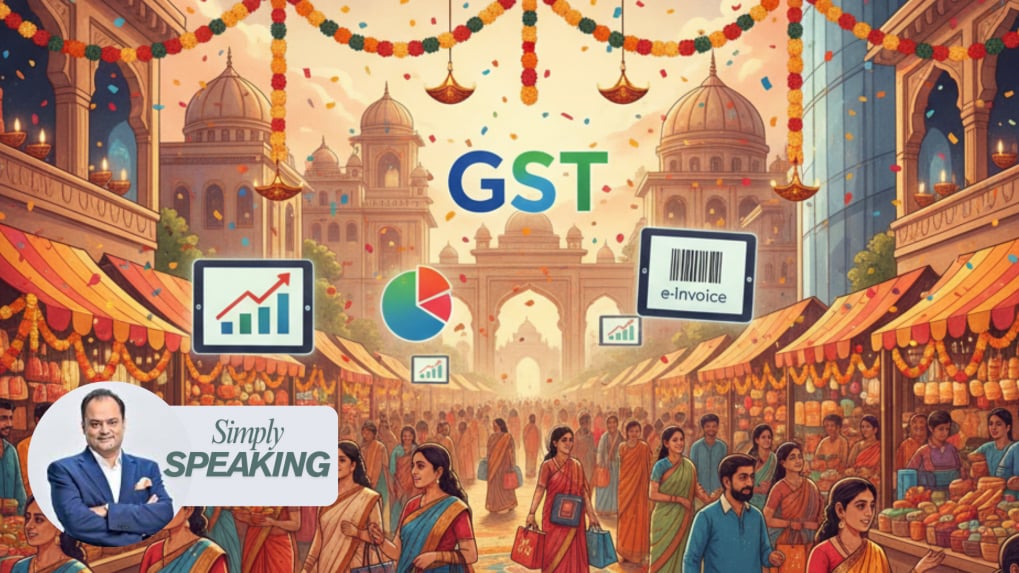Simply Speaking: Pahlee Diwali? GST Bonanza Unlocking Demand, Fostering Inclusion
India’s GST 2.0 has set off a new phase of consumption-led growth, but beneath the visible surge, deeper market currents are at play.
ADVERTISEMENT
A single, simplified tax reform may be the catalyst, yet it is the subtle shift in consumer sentiment and sectoral behaviors that reveal its true impact. For our economy, this was a vital input. Let’s examine it in detail from a consumer marketer’s perspective.
Urban vs Rural: Twin engines of growth
The GST overhaul is about slashing rates to just two principal slabs and comes at a time when private consumption has been recovering unevenly between India’s cities and hinterland. Urban demand, though decelerated by recent inflation and muted income growth, is showing signs of underlying resilience, especially in digital-first categories and premium service sectors. Strong growth in electronic payments and spending across small urban enterprises signals real consumer confidence, even when headline numbers understate the momentum.
Yet, rural India is the surprise engine. With staples, household goods, entry-level autos, and packaged food shifting to the five percent merit rate, projections show an 8–10% rise in rural demand through festivals, with kirana stores and small distributors set to gain more liquidity and credit access than ever before.
The democratization of input tax credits and price rationalization promise lasting gains, shifting rural demand from unorganized to organized channels.
Recalibrating value - Premium vs Mass Segments
GST 2.0’s biggest immediate win is for mass-market consumers. FMCG majors, automobile makers, and digital platforms are revising prices downward, especially on staples, white goods, and entry-level products.
For lower-priced packs and essentials, grammage increases and price drops will directly benefit the consumer, with the effect magnified in Tier-2 and Tier-3 markets.
In contrast, premium and luxury segments face new headwinds. While daily essentials are cheaper, GST on luxury cars, wedding wear, business class air travel, and sin goods, has been raised substantially to 18 percent or 40 percent.
Players in premium fashion, high-end electronics, and hospitality are recalibrating strategies, as volume-led growth in mass segments now outpaces margin-driven growth in premium categories. This will drive brands to innovate affordable health, wellness, and lifestyle products, capturing aspirational demand without crossing into higher tax brackets.
Festive Boost and Formalisation: A virtuous cycle
Rolling out GST just as Navratri and Diwali approach gives the reform immediate tailwinds. After quarters of weak urban sentiment, festive demand acts as both proof and catalyst. E-commerce platforms report transaction spikes upwards of 30%, with every compliant click expanding the tax net and formalizing the digital economy.
This formalization isn’t just about government revenues since better records mean greater access to small business credit, improved distributor liquidity, and rising faith in digital payments in smaller towns. As GST compliance becomes more seamless with pre-filled returns and smoother MSME registrations, the friction for small retailers and roadside kiranas lessens, making inclusion possible for millions.
Consumer savings are a demand multiplier
Lower effective tax rates on daily goods, electronics, and auto segments mean fresh savings for consumers. These small wins accumulate: more available cash translates into fresh demand in adjacent categories, driving a new virtuous cycle of spending and sectoral growth.
All is well ? Signals of Stability, Cues for Caution
The reform sends a global signal for scale and credibility. However, the onus now falls on business leaders and policymakers. The twin challenge is to avoid complex compliance that could slow inclusion, and to balance affordable growth with sustainable fiscal discipline.
The GST story is both celebration and test. Success will be measured not just in festival quarters, but in the quieter seasons .If when rural demand stays resilient, mass markets keep expanding, and premium segments adapt without stalling innovation.
Only then will India’s consumption led bonanza truly mature into inclusive, sustainable growth.
Shubhranshu Singh is a business leader , cultural strategist and columnist. He was named as one of the 50 most influential global CMOs for 2025 by Forbes. He serves as the APAC representative on the EffieLIONS foundation board.
Read More: Simply Speaking: Memory Makes Magic - “What’s Your Brand’s Madeleine?”
Read More: Simply Speaking: Brands are born inside
Read More: Simply Speaking: When buybacks beat breakthroughs


